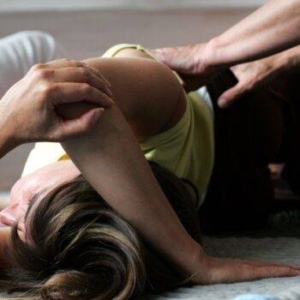Feldenkrais & Contemporary Living

Feldenkrais & Contemporary Living
Article from Psychology Today, Nov/Dec 2010
“Move Freely” – The Feldenkrais Method improves movement through awareness, by Virginia VanZanten
The Feldenkrais method may not have yoga’s ubiquity or Tai Chi’s foreign flare, but a loyal group of about 6,000 practitioners worldwide credit this system of somatic education with everything from increasing range of motion to easing stress.
Feldenkrais is a series of simple kinetic lessons and verbal directives that help students pay attention to their movements and, if necessary, modify them for maximum efficiency. Developed by Israeli physicist Moshe Feldenkrais in the 1950s, the approach has long been in the canon of mind-body medicine.
The goal of Feldenkrais is to retrain the muscles that slip into detrimental patterns, like tensing your shoulders when you’re frazzled, says Erin Ferguson, a practitioner in Boulder, Colorado. When you break the physical cycle, the theory goes, often the underlying emotional cycle-in this case, of stress-lessens, too.
Ferguson believes the method has remained relatively under-the-radar because of our society’s penchant for results rather than process. “People don’t want to slow down and become aware of what they’re doing,” she says. “They want quick fixes, which Feldenkrais is not.”
During a session, a practitioner asks patients to make a simple movement: walking, or raising an arm, while turning in to the mechanics. The practitioner then suggests subtle shifts to make the motion easier on the body, calling attention to, say, the way the heel hits the ground or how the ribs flex. By recognizing how their muscles and skeletons interact, Feldenkrais students can choose the most comfortable way to move.
In an American Journal of Pain Management study, patients with chronic pain reported huge gains in mobility an decreased pain after a six-week Feldenkrais course, with continued benefits on year later. Other research suggests the method boosts mobility and improves function in patients with brain trauma, autism, stroke, arthritis, and multiple sclerosis. Athletes, dancers, and musicians often turn to Feldenkrais to hone their movement.
“People are hooked by how much change they can create via paying attention to their movement,” Ferguson says. “The intelligence is indisputably affecting.”
Sample Exercise
1. While sitting, slowly turn your head and eyes together to the right, keeping your shoulders forward. Stop when you feel any strain and note that point. Return to center.
2. Turn your head and eyes to the same spot and then, keeping your head still, let only the eyes move to the left and then back to the right again. Repeat ten times, gently sliding your gaze to the left and back.
3. Move your head and eyes back to the center, and repeat all the steps on the left side.
4. Now test how far you can move on either side.
www.feldenkrais.com